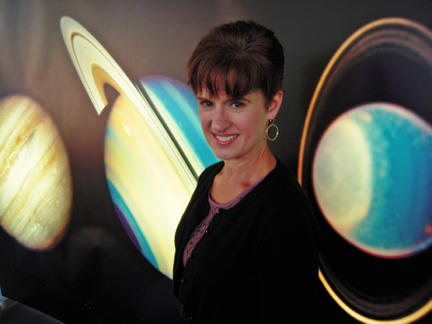By Tiffany Bentley
When the James Webb Space Telescope launches in 2018 as the successor to Hubble, it will look deeper into space — beyond the reach of existing instruments — to see the earliest stars and galaxies that formed in the Universe. It will detect stars approximately 280 million years older than those seen by Hubble.

Sharon Smith Donahue ’86
An international collaboration between NASA, European Space Agency, and Canadian Space Agency, design and construction of the Webb telescope has involved 14 countries and more than 100 companies.
Leading one crucial piece of the project at one of those companies is Sharon Smith Donahue ’86, senior project staff engineer with Stinger Ghaffarian Technologies, Greenbelt, Md. She is overseeing activities associated with the development of the optical telescope element simulator (OSIM).
OSIM is a cryogenic optical simulator used for testing. The massive piece of equipment will not be attached to the telescope but will verify measurements on the ground, which are needed for precision integration of the instruments. “OSIM will optically stimulate the scientific instruments to verify their operation and performance,” explains Donahue. The project is scheduled for completion in June 2012.
The Webb, a large, infrared-optimized space telescope, will have three major elements — the integrated science instrument module, optical telescope element, and the spacecraft itself. These will be tested prior to delivery for observatory integration and testing scheduled to begin in 2012.
Donahue, as coordinator for Stinger Ghaffarian’s mechanical systems engineering services contract with NASA’s Goddard Space Flight Center, forms talented teams to accomplish various tasks besides the OSIM project.
Prior to joining Stinger Ghaffarian in 2007, Donahue worked 15 years with Orbital Sciences and across several other contracts collaborating with Goddard’s scientists and engineers on NASA’s unmanned scientific spacecraft program. In addition to OSIM, she also led the successful capability maturity model integration (CMMI) re-certification project.
Donahue holds a master’s degree in computer science from Johns Hopkins University and an MBA in finance from University of Maryland’s Robert H. Smith School of Business.
Earlier in her life Donahue dreamed of following in her father’s footsteps to become a doctor. But receiving a “less than substantial” grade in organic chemistry at Lafayette gave her pause. “It rocked the whole perception of my life,” she says.
Donahue, however, mastered the coursework in an elective computer science class. Impressed by her aptitude, her professor recommended that she consider a career in mathematics and computer science. Heeding that advice, she changed direction and graduated with degrees in biology and mathematics.
“The fact that I could earn a second degree was literally life-changing,” says Donahue.
Donahue continues to promote the Amateur Radio on the International Space Station (ARISS) program, which 15 years ago was the first project she managed for Goddard Space Flight Center. Astronauts and cosmonauts aboard the International Space Station speak with school groups and youth organizations via amateur radio. The project’s purpose is to inspire children’s interest in science, technology, engineering, and math (STEM) fields.
A mother of three, Donahue says being passionate about her work is only one part of her contentment.
“Balancing work and weaving it into a home life has been the key component in my happiness,” says Donahue, who is particularly thankful for her husband, Thomas, who has helped her achieve that balance.
# # # # #
COMPARING WEBB AND HUBBLE
The primary mirror on the Webb telescope will be 21.3 feet in diameter, 2.5 times larger than Hubble’s. It also will have infrared instruments with longer wavelength coverage and greatly improved sensitivity. Finally, it will operate much farther away — orbit about 1.5 million km (1 million miles) from the Earth — maintaining its extremely cold-operating temperature, stable pointing, and higher observing efficiency. Hubble, launched in 1990, is now expected to function until at least 2014.
Read more about Webb
